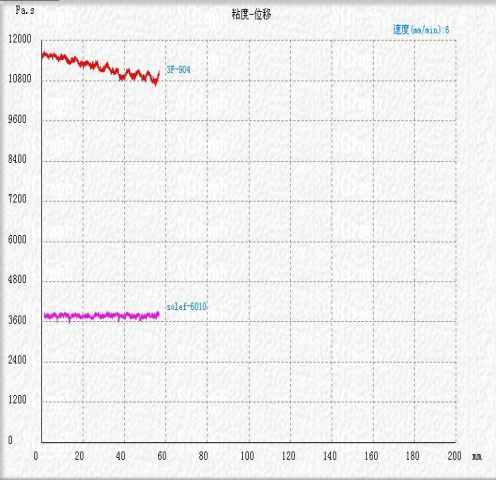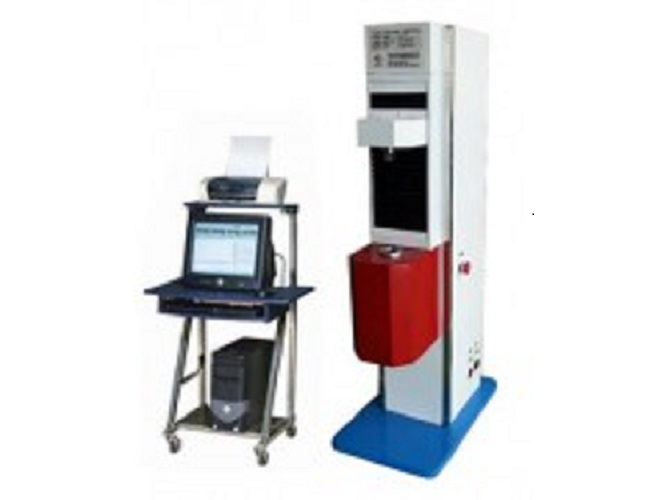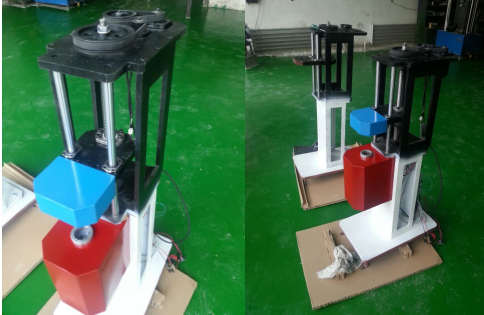
热固性材料毛细管流变仪 毛细管流变仪可以测定高聚物的软化点、熔点、流动点、粘度粘流活化能,热固性材料的固化温度等性能指标。这些数据对研究高聚物流变性能有重要的作用。
热固性材料毛细管流变仪 试验原理
毛细管流变仪测试的基本原理是:设定一个无限长的圆形毛细管中,塑料熔体在管中的流动为一种不可压缩的粘性流体的稳定层流流动;由于流体具有粘性,它必然受到来自管壁与流体方向相反的作用力。通过粘滞阻力应与推动力相平衡等流体力学过程原理的推导,可得到管壁处的剪切应力和剪切速率与压力、熔体流速的关系如下:
材料流经毛细管时的剪切应力为:
τ=R?⊿P/2L
(1)
其中 R—毛细管的内半径,这里 R=0.635 mm
⊿P—材料流经毛细管的压力差kg/cm2
L—毛细管的长度,例如选择长径比为30:1的毛细管,L=38.1mm
剪切速率为:  =4Q/πR3
=4Q/πR3
(2)
其中 Q—挤出流量cm3/s
由此,在温度和毛细管长径比(L/2R)一定的条件下,测定不同的压力下塑料熔体通过毛细管的流动速率Q,由流动速率和毛细管两端的压力差⊿P,可计算出相应的剪切应力和剪切速率,将一组对应的τ和 在对数座标纸上绘制流动曲线,即可求得非牛顿指数(n)和熔体的表观粘度(ηa);改变温度或改变毛细管长径比,则可得到代表粘度对温度依赖性的粘流活化能;以及离模膨胀比等表征流变特性的物理参数。
在对数座标纸上绘制流动曲线,即可求得非牛顿指数(n)和熔体的表观粘度(ηa);改变温度或改变毛细管长径比,则可得到代表粘度对温度依赖性的粘流活化能;以及离模膨胀比等表征流变特性的物理参数。
设备功能及特点:
1、毛细管流变仪流变仪为计算机测控智能化恒压式毛细管流变仪,能在恒压下和恒速度下工作,通过计算机测定各种压力作用下的各种规格毛细管在不同的升温速率下、不同温度时的挤出速度。通过计算机,记录挤出速度、压力和加热温度。自动处理成粘度数。并绘制曲线,打印完整报告单。
2、毛细管流变仪为测定高分子材料的流动性和固化速度。测定高分子材料熔体的粘度及粘流活化性,还能进行研究熔融纺丝的工艺条件。
3、毛细管流变仪可以测定高聚物的软化点、熔点、流动点、粘度粘流活化能,热固性材料的固化温度等性能指标。
4、控温系统及控制方式性能优越,利于测定不同温度下高分子材料的变化及相关性能。此仪器用计算机控制并绘制试验曲线,显试时时曲线变化,并得出的agen-poiseuille、Rabinowitsch、melt flow rute等方程数据。
5、毛细管流变仪采用负荷加载,设计合理,计算机控制并实现负荷连续加载,控制精度高,稳定性能好。毛细管流变仪可绘制高分子材料的应力应变曲线、塑化曲线,测定软化点、熔融点、流动点的温度。并绘制曲线,打印完整报告单。
参数:
(1) 测试速度 0.005-20 mm/min
(2) 负荷测试精度 ?0.5%
(3) 负荷分辨率100000码
(4) 位移精度 ?0.5%
(5) 变形精度 ?0.5%
(6) 变形分辨率 0.01mm
(7) 动态速度比 1:40,000
(8) 最高测试温度 400?C
(9) 温度控制 PID控制,解析度0.1?C,误差度<?O.5?C
(10) 升温速率1-10℃/min,连续可调,并可快速升温
(11) 控温精度显示<?0.5℃
(12) 温度分辨率0.1℃
(13) 料筒直径 11.28 mm:15mm:9.5 择一
(14) 加热料筒长度 200 mm
(15) 料筒材质 碳化钨
(16) 测试膛 电子加热测试膛,抽换式料筒
此仪器机械传动部件采用进口滚珠丝杆,传动效率更精确、传动更稳定、加以进口伺服器控制系统及进口伺服电机使此仪器的使用更长久、精度更精准耐用、更大的满足用户的需求。
此仪器并配有进口荷载力传感器,使此仪器测力精度高、力值准确度高、稳定。并可以大大满足用户要求,可以扩展力值量程范围。使得用户的测试范围更大、便于用户选择更适合试验的仪器。
配置名称
1. 试验主机
2. 高精度控温表
3. 进口伺服控制系统
4. 进口伺服电机
5. 数据采集系统
6. 数据处理系统
7. 高精度传感器
8. 专用出料模口
9. 5/1、10/1、20/1、40/1mm(标配)
10. 专用口膜托件
11. 品牌计算机
12. 彩色喷墨打印机
13. 专用试验软件
14. 专用工具
15. 说明书
数据处理1、启动操作应用软件。
2、输入实验报告信息。
3、添加数据文件及输入实验参数,进行试验操作。
4、筛选数据。查看筛选的数据,检查数据的有效性和合理性。
5、显示曲线,显示数据。
6、试验结束,打印保存数据及曲线。
7、关闭系统。
主界面集多功能于一体,程序主界面包括:系统菜单区、示值显示面板、试验过程区、曲线显示区。
流变性能的仪器一般称为流变仪,有时又叫粘度计。在测定和研究塑料熔体流变性的各种仪器中,毛细管流变仪是一种常用的较为合适的试验仪器,它具有多种功能和宽广范围的剪切速率容量。毛细管流变仪即可以测定塑料熔体在毛细管中的剪切应力和剪切速率的关系,又可以根据挤出物的直径和外观或在恒定应力下通过改变毛细管的长径比来研究熔体的弹性和不稳定流动(包括熔体破裂)现象。从而测其加工行为,作为选择复合物配方、寻求最佳成型工艺条件和控制产品质量的依据;或者为辅助成型模具和塑料机械设计提供基本数据。
实验原料
热塑性塑料如PE、PP、PS及其复合物粉料、粒料、条状薄片或模压块料等;实验前应根据材料类别和性质作相应处理,如干燥等。
当塑料熔体通过毛细管口模时,由安装在毛细管口模处的压力传感器和热电偶测试出熔体的压力和温度,微机记录下熔体压力和温度数值。
Capillary rheometer can measure the softening point, melting point, flow point, viscosity and viscous flow activation energy of polymers, as well as the curing temperature of thermosetting materials and other performance indicators. These data play an important role in studying the rheological properties of polymers.
Experimental principle
The basic principle of capillary rheometer testing is to set the flow of plastic melt in an infinitely long circular capillary tube as a stable laminar flow of incompressible viscous fluid; Due to the viscosity of the fluid, it is inevitably subjected to forces from the pipe wall in the opposite direction of the fluid. By deducing the principles of fluid mechanics processes such as the balance between viscous resistance and driving force, the relationship between shear stress and shear rate at the pipe wall, pressure, and melt flow rate can be obtained as follows:
The shear stress when the material flows through the capillary is:
τ= R? ΔP/2L
(1)
Where R - the inner radius of the capillary, where R=0.635 mm
ΔP - Pressure difference of the material flowing through the capillary tube, kg/cm2
L - The length of the capillary tube, for example, when selecting a capillary tube with a aspect ratio of 30:1, L=38.1mm
The shear rate is:=4Q/πR3
(2)
Where Q - extrusion flow rate cm3/s
Therefore, under certain conditions of temperature and capillary aspect ratio (L/2R), the flow rate Q of plastic melt passing through the capillary under different pressures can be measured. Based on the flow rate and the pressure differenceΔP at both ends of the capillary, the corresponding shear stress and shear rate can be calculated. A set of correspondingτBy plotting the flow curve on logarithmic coordinate paper, the non Newtonian index (n) and the apparent viscosity of the melt can be obtained( ηa) ; By changing the temperature or capillary aspect ratio, the viscous flow activation energy representing the temperature dependence of viscosity can be obtained; And physical parameters such as the expansion ratio of the mold to characterize the rheological properties.
Equipment functions and characteristics:
1. The capillary rheometer is a computer-controlled intelligent constant pressure capillary rheometer that can operate at constant pressure and speed. It measures the extrusion speed of various specifications of capillaries under various pressures at different heating rates and temperatures through a computer. Record the extrusion speed, pressure, and heating temperature through a computer. Automatically processed into viscosity number. Draw curves and print the complete report.
2. Capillary rheometer is used to measure the flowability and curing rate of polymer materials. Measuring the viscosity and viscous flow activation of polymer material melts can also be used to study the process conditions of melt spinning.
3. Capillary rheometer can measure the softening point, melting point, flow point, viscosity and viscous flow activation energy of polymers, as well as the curing temperature of thermosetting materials and other performance indicators.
4. The temperature control system and control method have superior performance, which is conducive to measuring the changes and correlations of polymer materials at different temperatures
业务咨询:932174181 媒体合作:2279387437 24小时服务热线:15136468001 盘古机械网 - 全面、科学的机械行业免费发布信息网站 Copyright 2017 PGJXO.COM 豫ICP备12019803号